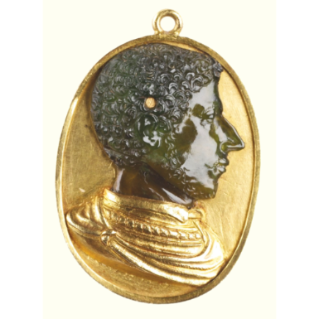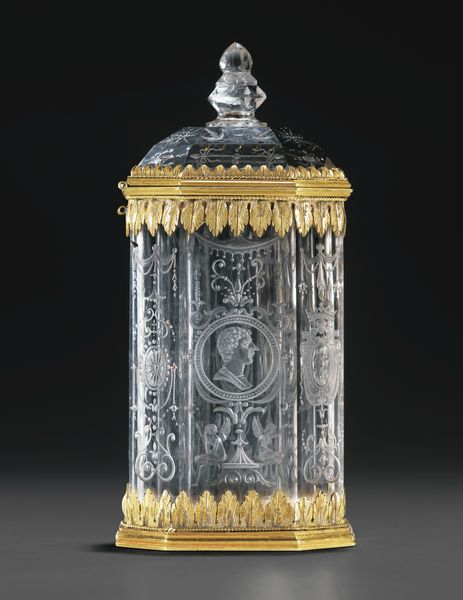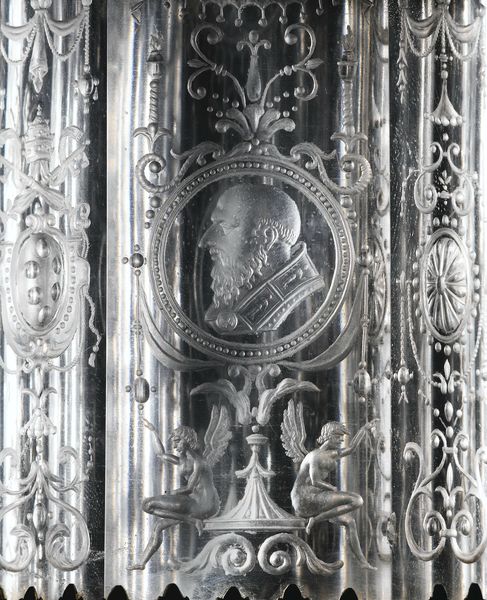Vessel with portraits of Pope Clement VII (1478-1534) and Alessandro De' Medici, Duke of Florence (1511-1537)
Vessel with portraits of Pope Clement VII (1478-1534) and Alessandro De' Medici, Duke of Florence (1511-1537). Photo courtesy Sotheby's
rock crystal, with possibly French, late 16th/ early 17th century gilt copper mounts; 14.3cm., 5 5/8 in. overall. Estimate 150,000-300,000 GBP
PROVENANCE: with Heinz Jürgen Heuser, Hamburg, 1962
LITTERATURE: H. Burns, M. Collareta and D. Gasparotto, Valerio Belli Vicentino (1468c-1546), Vicenza, 2000, no. 25 (there identified as possibly being a work by Valerio Belli)
NOTE: This superb rock crystal vessel compares with some of the finest hardstone carvings of the first half of the 16thcentury. The presence of portraits of Pope Clement VII and Alessandro de’ Medici, indicate that it was an important commission, celebrating the close relationship between two powerful members of the Medici dynasty: a lost treasure from the Italian High Renaissance.
The Carving
The mannerist ornamentation, which covers the surface of the present vessel, is close to the work of Giovanni Bernardi (1494-1553), the celebrated gem-cutter and rock crystal engraver to the ducal Este and Medici courts, and to Pope Clement VII. Note the similar scrolling vegetal forms terminating in volutes, adorned with dot patterns, and interspersed with exotic birds and mythical creatures, on a series of rock crystal panels in the Museo Nazionale di Capodimonte, Naples, which are attributed to Bernardi (Cassani, op. cit., nos. 6.3-6.68). As with the present vessel, these panels have been carved using theintaglio technique (explained below). The hanging drapes find a conceptual parallel in the garlands of fruit and flowers appearing on another of the panels from Capodimonte (Cassani, op. cit., no. 6.41). The portrait profile medallions of Clement VII and Alessandro de’ Medici should be compared with Bernardi’s rock crystal panels with the Apostles also at Capodimonte (Cassani,op. cit., no. 6.1). Observe the same excellent clarity of the carving. The oval medallions, encircled with dots, are very similar to those appearing prominently on a rock crystal dish by Bernardi in the Museo degli Argenti at the Palazzo Pitti, Florence (inv. no. Bg. 1917 (III) no. 13). The affinities with Bernardi’s oeuvre place the present vessel firmly within his circle, and confirm that it is the work of a master working in the same virtuoso tradition.
The Rock crystal
The body, lid and underside of this vessel were carved from a mineral formed from silicon and oxygen known as quartz. Here, the mineral appears transparent and colourless, a type referred to as pure quartz or, more commonly, rock crystal. In the right conditions, pure quartz crystals can grow up to one metre in length and the material forms with a hexagonal cross-section.
For the body of the present lot, the lapidary used hexagonal rock crystal of which the basic shape was possibly retained to emphasise its origin. The lapidary has left the body very thin in order for the material to appear clear and light in weight. Hollowing the raw material out like this was a delicate operation requiring great skill. It is likely that the cylindrical opening was made into the crystal by boring into it using a hand drill, which needed to be constantly lubricated by a course mixture of water and sand in order to penetrate properly. Following drilling, the shape was ground down further with an abrasive like emery or corundum, creating the sharp angles and level surfaces that characterise the present vessel. The delicate foliate decoration, coats of arms and portraits were then engraved intaglio into the surface with burin-like tools and cutters. During the hollowing out and engraving of the surface, the lapidary had to be particularly careful so as not to crack the fragile crystal. Lastly, the object was polished throughout with wooden or leather tools and a softer abrasive in order to create its glass-like translucency. Much like the hexagonal shape of the body of the vessel, the rock crystal lid was possibly carved with facets to mimic natural quartz formations, which terminate in a similar way.
Rock crystal has been carved since Prehistoric times. Ornaments made from the mineral appear regularly at excavations at Neolithic sites around the world. Quartz also features in most early treatises on geology, such as Jin Ni Zi (China, 4th-century BCE) and Pliny the Elder’s Naturalis Historia (Roman, 1st century CE). The latter’s opinion was that the material was petrified ice, which had become permanently frozen over many centuries. The production of rock crystal vessels flourished in the Western world from the 9th century onwards when it became a staple material used for Christian liturgical objects. Christians associated the purity and clarity of the quartz with the chastity and conscientiousness of their saints and therefore employed the material in objects used during the mass and reliquaries. Roughly around the same time, rock crystal objects became highly prized possessions of the Muslim Fatimid civilisation, which undoubtedly traded the material intensively with Europeans. A contemporary account mentions some 36,000 items of rock crystal and cut glass in the treasuries of Cairo.
As the centuries progressed, rock crystal was worked with increasing cunning and complexity in Europe. During most of this development, the stone-cutter was entirely subservient to the goldsmith. But the rediscovery of the ancient lapidaries and the hunger for ever more opulent gems for the ruling classes cultivated the art form's finest hour. By the second quarter of the 16th century, the lapidaries’ position was reversed and caused schools to flourish first in Milan and Florence, and later in cities such as Prague and Freiburg. The three most impressive collections of rock crystal carvings still intact today -the Florentine Grand-Ducal collection at the Palazzo Pitti, the collection of the Habsburgs in the Kunsthistorisches Museum in Vienna, and the Wittelsbach collection in Munich- were all formed by important noblemen at this time. They contain several reappropriated crystals, but chiefly consist of carvings commissioned from the main gem-cutters active in the 16th century: Annibale Fontana, the Sarracchi, the Miseroni, Giovanni Ambrosio, Valerio Belli and Giovanni Bernardi. Their work is characterised by a command over the material that leads to an enormous array of shapes and the fanciful engraving that is also seen on the present vessel.
The Portrait Medallions: The Sitters
The portrait roundels carved into the present vessel are close to known 16th-century medals and hardstone carvings with representations of Pope Clement VII and Alessandro de’ Medici, Duke of Florence. In 1534, Giovanni Bernardi and Benvenuto Cellini (1500-1571) engaged in a competition to create the archetypal portrait medal of Clement VII. Cellini’s portrait of Clement is, in fact, very close to that appearing on the present vessel; note the similar domed head and beard with ringlets (fig. 1). Images of Alessandro de’ Medici were, perhaps unsurprisingly, less widely circulated than those of the Pope, with some of the finest being carved in precious materials. The present portrait of Alessandro can be compared with a chalcedony and gold pendant in the Victoria and Albert Museum, London (inv. no. CIS 7553-1861), in which Alessandro is also represented with a prominent nose and hair curling tightly to his scalp (see fig. 2). Another relevant comparison is found in the chalcedony portrait of Alessandro by Domenico di Polo (1480-c.1547) in the Museo degli Argenti, Florence (inv. no. GFSSPMF 205069). Cellini also modelled a portrait medal of Alessandro, which has a similar arrangement of clothing to that seen in the present vessel, a silver cast is in the Museo Nazionale del Bargello, Florence (see Chong, Pegazzano and Zikos, op. cit., p. 152, fig. 77).
 Giulio di Giuliano de' Medici, Pope Clement VII (1478-1534) is remembered for being the Pope who fled to the safety of the Castel Sant’Angelo during the Sack of Rome of 1527 and for presiding over the divorce proceedings between Henry VIII of England (1491-1547) and Catherine of Aragon (1485-1536), which resulted in the English Reformation. Born in Florence, in 1478, he was the nephew of Lorenzo the Magnificent, and was a cousin of Pope Leo X (1475-1521). When Leo ascended to the Papacy in 1513, Giulio di Giuliano was swiftly appointed Archbishop of Florence and was made a Cardinal. He established himself as one of the most powerful figures in the Church and, following the death of Adrian VI (1459-1523) in 1523, was elected Pope, styling himself Clement VIII.
Giulio di Giuliano de' Medici, Pope Clement VII (1478-1534) is remembered for being the Pope who fled to the safety of the Castel Sant’Angelo during the Sack of Rome of 1527 and for presiding over the divorce proceedings between Henry VIII of England (1491-1547) and Catherine of Aragon (1485-1536), which resulted in the English Reformation. Born in Florence, in 1478, he was the nephew of Lorenzo the Magnificent, and was a cousin of Pope Leo X (1475-1521). When Leo ascended to the Papacy in 1513, Giulio di Giuliano was swiftly appointed Archbishop of Florence and was made a Cardinal. He established himself as one of the most powerful figures in the Church and, following the death of Adrian VI (1459-1523) in 1523, was elected Pope, styling himself Clement VIII.
Clement held the papacy during a particularly turbulent period in the life of the Church. Only six years prior to his election as Pope, Martin Luther (1483-1546) had nailed his Ninety-Five Theses to the door of All Saint’s Church in Wittenberg, sparking the beginnings of the greatest crisis to engulf the Roman Church in its history, the Reformation. Clement, although highly intelligent, was a weak leader, whose actions caused events to spiral beyond his control. His lack of diplomatic foresight in repeatedly changing allegiances between the opposing powers of the Holy Roman Empire and France led to the Sack of Rome of 1527. This humiliation resulted him being placed under the control of Charles V, the nephew of Catherine of Aragon. When Henry VIII requested that his marriage to Catherine be annulled in 1527, Clement, fearing Charles’ wrath, procrastinated. His patience wearing thin, Henry ordered his marriage to be annulled, and, in late 1532/ early 1533, he married his mistress Anne Boleyn (c. 1501-1536). Clement responded by excommunicating both Henry and his Archbishop, Thomas Cramner (1489-1556), but it was too late. By 1534, the Act of Supremacy had been passed establishing an independent Church of England with Henry at its head; the English Reformation had begun.
Whilst Clement was a poor diplomat and politician, he was an important patron of the arts. One of his last acts as Pope was to commission Michelangelo to paint theLast Judgment in the Sistine Chapel. (Photo: Benvenuto Cellini, Medal of Clemet VII, 1534. Florence, Museo Nazionale delBargello)
 Alessandro de’ Medici (1511-1537) was the first hereditary Duke of Florence. He was known by contemporaries as Il Moro, The Moor, because of his mixed race heritage – his mother is recorded as having been a sub-Saharan African named Simonetta da Collavecchio, who is thought to have worked in service and was possibly a slave. Officially, Alessandro was the illegitimate son of Lorenzo II de’ Medici (1492-1519), grandson of Lorenzo the Magnificent (1449-1492). However, today, it is believed that his real father was the seventeen year old Cardinal Giulio de’ Medici, the future Pope Clement VII, whose portrait also appears on the present vessel.
Alessandro de’ Medici (1511-1537) was the first hereditary Duke of Florence. He was known by contemporaries as Il Moro, The Moor, because of his mixed race heritage – his mother is recorded as having been a sub-Saharan African named Simonetta da Collavecchio, who is thought to have worked in service and was possibly a slave. Officially, Alessandro was the illegitimate son of Lorenzo II de’ Medici (1492-1519), grandson of Lorenzo the Magnificent (1449-1492). However, today, it is believed that his real father was the seventeen year old Cardinal Giulio de’ Medici, the future Pope Clement VII, whose portrait also appears on the present vessel.
Surprisingly little has been written about Alessandro. Less still has been said about his parentage, probably due to discomfort felt by past historians, who wished to ignore his African heritage and his possible status as the illegitimate son of a Pope. Contemporaries appear not to have been concerned with Alessandro’s race, however. Like many absolute rulers of the period, he had scores of enemies. Rather than chastising him for his skin colour, though, they insulted him for being the son of a peasant. Class was clearly more important in Florentine society than race. This is, perhaps, unsurprising, given that many Africans were brought to Italy to work in aristocratic households, where they were welcomed as exotic additions and prized as symbols of wealth and prestige. The 16th- and 17th-century fascination with Africans is manifested by the numerous busts of Moors carved in expensive materials, such as those by Nicolas Cordier (1567-1612)(see the superb example in the Grünes Gewölbe, Dresden: inv. no. Hm2 187a).
Alessandro de’ Medici was installed as Duke of Florence by the Holy Roman Emperor Charles V (1500-1558) in 1530, following the defeat and absolution of the Florentine Republic. Charles clearly regarded Alessandro as an important political ally, betrothing his daughter Margaret of Austria (1522-1586) to him in 1527. Alessandro was known as a relatively informal leader, and was praised for his generosity and for his concern for the poor. His life came to a brutal end in 1537, when he was murdered by his cousin Lorenzino de’ Medici (1514-1548), who was referred to as Lorenzaccio, ‘Bad Lorenzo’, for his unfortunate habit of vandalising statues. Lorenzino, who had claimed that he wished to restore the Florentine Republic, was tracked down by Alessandro’s successor Cosimo I de’ Medici and executed in 1548. (Photo: Possibly by Domenico de' Vetri (about 1480-1547), Cameo, with a portrait of Alessandro de' Medici, 1532-7. Plasma (green chalcedony) in gold setting. Victoria and Albert Museum, London)
The Commission
The presence of portraits of Clement VII and Alessandro de’ Medici, together with their respective coats of arms, strongly indicates that the vessel was commissioned either by one of these individuals, or by someone close to them. In the absence of documentary evidence, it is impossible to be exactly sure of the patron’s identity. However, what is clear, is that the person must have been immensely wealthy and at the top of society; such objects were the preserve of princes, dukes and Popes.
There are three likely scenarios for the commission of the present vessel. As has been outlined above, Clement VII and Alessandro de’ Medici were very close, possibly even father and son. Clement had vigorously supported Alessandro’s appointment as Duke of Florence in 1530, a development that he had seen as crucial for retaining Medici dominance in Italian politics. It is therefore possible that the vessel would have been ordered to celebrate this appointment and the security it afforded to the Medici dynasty. Another scenario is that it was commissioned by Alessandro following the death of Clement in 1534, at a time when Alessandro was at the height of his power as Duke of Florence. The vessel may have served as a commemorative piece and as a tribute from Alessandro to his natural father.
One final suggestion should be considered, however. Alessandro’s official sister, Catherine de Medici, Queen of France (1519-1589), amassed an important collection of rock crystal objects, many of which are now in the Palazzo Pitti. The most famous item from her collection is the Bowl of Diana of Poitiers by Gaspare Miseroni, dating to circa 1550 (inv. no. 1921 no. 540). Given that she was also very close to Clement VII – who had been her protector and had presided over her marriage to the future King Henry II of France – it seems very possible that Catherine may have commissioned the present vessel to commemorate the lives of two of her closest relatives.
RELATED LITERATURE: H. Hahnloser and S. Brugger-Koch, Corpus des Hartsteinschliffe des 12.-15. Jahrhunderts, Berlin, 1985; S. Cassani (ed.), Museo Gallerie Nazionale di Capodimonte. La Collezione Farnese, Naples, 1996, pp. pp. 165-176, nos. 6.1 – 6.68; A. Contadini, 'Rock Crystal: Rock Crystal Pieces in the V&A', Fatimid Art at the Victoria and Albert Museum. London, 1998; D. Alcouffe, Les Gemmes de la Couronne, exh. cat. Musée du Louvre, Paris, 2001, pp. 230-323; A. Chong, D. Pegazzano and D. Zikos, Raphael, Cellini and A Renaissance Banker, exh. cat. Isabella Stewart Gardner Museum, Boston, and Museo Nazionale del Bargello, Florence, Boston, 2004, p. 152, figs. 76-77; M. Mosco and O. Casazza, The Museo degli Argenti. Collections and Collectors, Florence/ Milan, 2004, pp. 70-72, fig. 9.
We would like to thank Daniel Alcouffe for his assistance in cataloguing this lot.
Sotheby's. Treasures, Princely Taste. London | 03 juil. 2013 - www.sothebys.com

/https%3A%2F%2Fprofilepics.canalblog.com%2Fprofilepics%2F1%2F0%2F100183.jpg)
/https%3A%2F%2Fstorage.canalblog.com%2F03%2F02%2F119589%2F96711876_o.jpg)
/https%3A%2F%2Fstorage.canalblog.com%2F11%2F31%2F119589%2F94773502_o.jpg)
/https%3A%2F%2Fstorage.canalblog.com%2F20%2F83%2F119589%2F94772815_o.jpg)
/https%3A%2F%2Fstorage.canalblog.com%2F26%2F72%2F119589%2F75604929_o.jpg)
/https%3A%2F%2Fstorage.canalblog.com%2F59%2F60%2F119589%2F26458628_o.jpg)









/http%3A%2F%2Fstorage.canalblog.com%2F91%2F49%2F119589%2F126680437_o.jpg)
/http%3A%2F%2Fstorage.canalblog.com%2F84%2F30%2F119589%2F126423170_o.jpg)
/http%3A%2F%2Fstorage.canalblog.com%2F70%2F61%2F119589%2F121366957_o.jpg)
/http%3A%2F%2Fstorage.canalblog.com%2F41%2F42%2F119589%2F121318481_o.jpg)